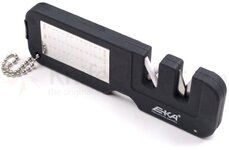- Messages
- 5,152
- Reactions
- 11,450
got the standard 53 kinds of stones/files/ceramics/powered thingies....
and granted a pocket knife needs a little different attention than a splitting maul....
Got fed up with the Lanski system; threw out a number of other stuff just outright too hoakie to even keep around another decade or 2 in the back drawer.......
mostly the fine sharp edge that needs touch up now & then;
I tend to prefer old style stones with different grit, yet the newer diamond 3"x 12" bench block seems to work.
And like others I've struggled for ~years~ to get to a decent edge with minimal effort;
don't care for the round pocket pucks; hate the notion another powered grindy thing is needed. "Kitchen Chef" works decent for the culinary stuff.
What's yore own best choice as "good enough" to put shaving edge on them Bowies & throwing hatches & gizzards & etc?
and granted a pocket knife needs a little different attention than a splitting maul....
Got fed up with the Lanski system; threw out a number of other stuff just outright too hoakie to even keep around another decade or 2 in the back drawer.......
mostly the fine sharp edge that needs touch up now & then;
I tend to prefer old style stones with different grit, yet the newer diamond 3"x 12" bench block seems to work.
And like others I've struggled for ~years~ to get to a decent edge with minimal effort;
don't care for the round pocket pucks; hate the notion another powered grindy thing is needed. "Kitchen Chef" works decent for the culinary stuff.
What's yore own best choice as "good enough" to put shaving edge on them Bowies & throwing hatches & gizzards & etc?












